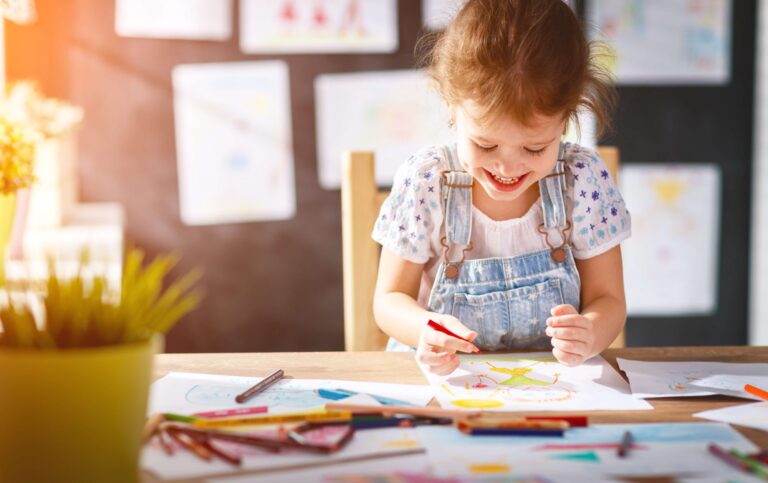
In today’s rapidly changing world, children are often caught up in a chaotic jumble of homework, extra activities, and digital distractions. Amid all this chaos, the calming and creative benefits of art for children stand out like a bright light. Welcome to the world of art therapy for children, a whole-person approach that helps children express themselves and feel better emotionally.
Learn More About Art Therapy
This is a form of therapy that uses the art-making process to help people feel better physically, mentally, and emotionally. Art for children becomes a powerful way for them to talk about their thoughts, feelings, and experiences while their language skills are still developing.
Healing
Drawing, painting, sketching, and making collages are just a few forms of art therapy. For children, this process allows them to explore their feelings without using words. Making things allows them to talk about their deepest feelings and thoughts in a safe, non-judgmental space.
Great Things for Kids
1. Emotional Expression:
Children can express complex emotions that they may find difficult to explain verbally through art. It allows them to connect their inner world with the outside world.
2. Increased Self-esteem:
When children complete art projects, they feel better about themselves and their self-confidence. The sense of achievement they get from completing a work of art makes them feel better about their self-image.
3. Stress Relief:
Children can relax and reduce stress by doing art activities. Art can help people who experience a lot of stress at school or have social problems to feel calm.
4. Problem Solving:
Choosing colors, shapes, and patterns in the art can help children think critically and solve problems. They can use these skills in many areas of life.
5. Social Development:
Group art therapy sessions can help people get to know each other, work together, and talk to each other. Children learn to collaborate on projects, share ideas, and accept the perspectives of others.
6. Coping Methods:
Children can process difficult emotions such as frustration, sadness, or anger healthily by creating art. Representing their emotions physically helps them understand and manage their emotions.
7. Get Stronger:
Exploring creativity can help children cope with new things and get back up after failure. Art therapy empowers people by teaching them to see mistakes as opportunities to learn and grow.
8. Better Communication:
For children who have difficulty expressing themselves verbally, art can be a powerful form of expression. Those who have difficulty communicating, learning, or growing will benefit the most.
9. Imagination and Artistic Talent:
Art therapy helps people use their imagination and creativity, which are important components of cognitive development. When children try different things and approaches, they become better at solving problems and coming up with new ideas.
10. Be Aware and Pay Attention:
Creating art requires focus and awareness. Art therapy can help you develop these skills so you can focus better and feel more present.
Using Art Therapy in Your Home
Parents and other adults who care for children can integrate art therapy into their daily lives, exposing them to different art materials, creating an art space, and engaging in creative activities with them. Promoting open communication about your child’s art will make it easier for him or her to express their feelings.
What a Trained Art Therapist does
While art activities at home can be very helpful, don’t forget the help of an experienced art therapist. Children receive therapy with trained professionals who help them understand their feelings, address specific problems, and find ways to cope.
Conclusion
In a world full of screens and programs, art therapy provides a safe place for children to learn, grow, and express themselves. It helps create a space where their personal perspectives are heard, valued, and celebrated. Recognizing how the arts change the minds of young people, let’s promote art therapy as part of school programs, mental health programs, and families’ daily routines. Through the profound art of healing, we can develop a future of strong, creative, and emotionally intelligent people.
FAQs
1. Which age group is suitable for art therapy?
Children of all ages can benefit from art therapy, even preschoolers. Tasks and methods can be adapted to children’s interests and stages of development.
2. Can art therapy help with certain behavioral problems?
Yes, art therapy is known to help with a variety of behavioral problems. It gives children a way to share and process their feelings without using words, helping them behave better and control their emotions.
3. Does a child have to be good at art to receive art therapy?
You don’t have to be good at art for art therapy. The way something is made is more important than the end result. It’s not about being good at art; It’s about expressing yourself, exploring, and letting go of your feelings.
4. What steps can parents take to use art therapy at home?
With a range of art supplies, parents can create an art space in their homes. There are some simple and effective ways to use art therapy at home. One of these is to encourage children to be creative and use art to share their thoughts and feelings.
5. Can art therapy replace conventional therapy?
Art therapy can help people as a supplement to traditional therapy or on its own. It gives people a unique way to express themselves, especially children who have difficulty talking to others.
6. Can something bad happen during art therapy with children?
Art therapy is generally considered safe and helpful. However, it is important to make sure the art therapist is licensed and has worked with children before. For some children, opening up through art can be difficult at first, so patience is important.